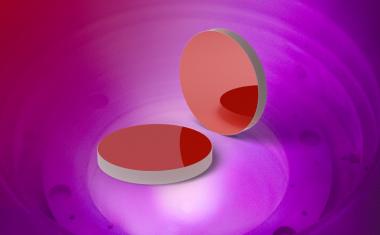Photonic filter separates signals from noise
Multifunctional filter could support future 6G wireless communication.
Researchers have developed a new chip-sized microwave photonic filter to separate communication signals from noise and suppress unwanted interference across the full radio frequency spectrum. The device is expected to help next-generation wireless communication technologies efficiently convey data in an environment that is becoming crowded with signals from devices such as cell phones, self-driving vehicles, internet-connected appliances and smart city infrastructure.

“This new microwave filter chip has the potential to improve wireless communication, such as 6G, leading to faster internet connections, better overall communication experiences and lower costs and energy consumption for wireless communication systems,” said Xingjun Wang from Peking University. “These advancements would directly and indirectly affect daily life, improving overall quality of life and enabling new experiences in various domains, such as mobility, smart homes and public spaces.” Now, the researchers describe how their new photonic filter overcomes the limitations of traditional electronic devices to achieve multiple functionalities on a chip-sized device with low power consumption. They also demonstrate the filter’s ability to operate across a broad radio frequency spectrum extending to over 30 GHz, showing its suitability for envisioned 6G technology.
“As the electro-optic bandwidth of optoelectronic devices continues to increase unstoppably, we believe that the integrated microwave photonics filter will certainly be one of the important solutions for future 6G wireless communications,” said Wang. “Only a well-designed integrated microwave photonics link can achieve low cost, low power consumption and superior filtering performance.” 6G technology is being developed to improve upon currently-deployed 5G communications networks. To convey more data at a faster rate, 6G networks are expected to use millimeter wave and even terahertz frequency bands. As this will distribute signals over an extremely wide frequency spectrum with increased data rate, there is a high likelihood of interference between different communication channels.
To solve this problem, researchers have sought to develop a filter that can protect signal receivers from various types of interference across the full radio frequency spectrum. To be cost-effective and practical for widespread deployment, it is important for this filter to be small, consume little power, achieve multiple filtering functions and be able to be integrated on a chip. However, previous demonstrations have been limited by their few functions, large size, limited bandwidth or requirements associated with electrical components.
For the new filter, the researchers created a simplified photonic architecture with four main parts. First, a phase modulator serves as the input of the radio frequency signal, which modulates the electrical signal onto the optical domain. Next, a double-ring acts as a switch to shape the modulation format. An adjustable microring is the core unit for processing the signal. Finally, a photodetector serves as the output of the radio frequency signal and recovers the radio frequency signal from the optical signal
“The greatest innovation here is breaking the barriers between devices and achieving mutual collaboration between them,” said Wang. “The collaborative operation of the double-ring and microring enables the realization of the intensity-consistent single-stage-adjustable cascaded-microring (ICSSA-CM) architecture. Owing to the high reconfigurability of the proposed ICSSA-CM, no extra radio frequency device is needed for the construction of various filtering functions, which simplifies the whole system composition.”
To test the device, researchers used high-frequency probes to load a radio frequency signal into the chip and collected the recovered signal with a high-speed photodetector. They used an arbitrary waveform generator and directional antennas to simulate the generation of 2Gb/s high-speed wireless transmission signals and a high-speed oscilloscope to receive the processed signal. By comparing the results with and without the use of the filter, the researchers were able to demonstrate the filter’s performance.
Overall, the findings show that the simplified photonic architecture achieves comparable performance with lower loss and system complexity compared with previous programmable integrated microwave photonic filters composed of hundreds of repeating units. This makes it more robust, more energy-efficient and easier to manufacture than previous devices. The researchers plan to further optimize the modulator and improve the overall filter architecture to achieve a high dynamic range and low noise while ensuring high integration at both the device and system levels. (Source: Optica)











